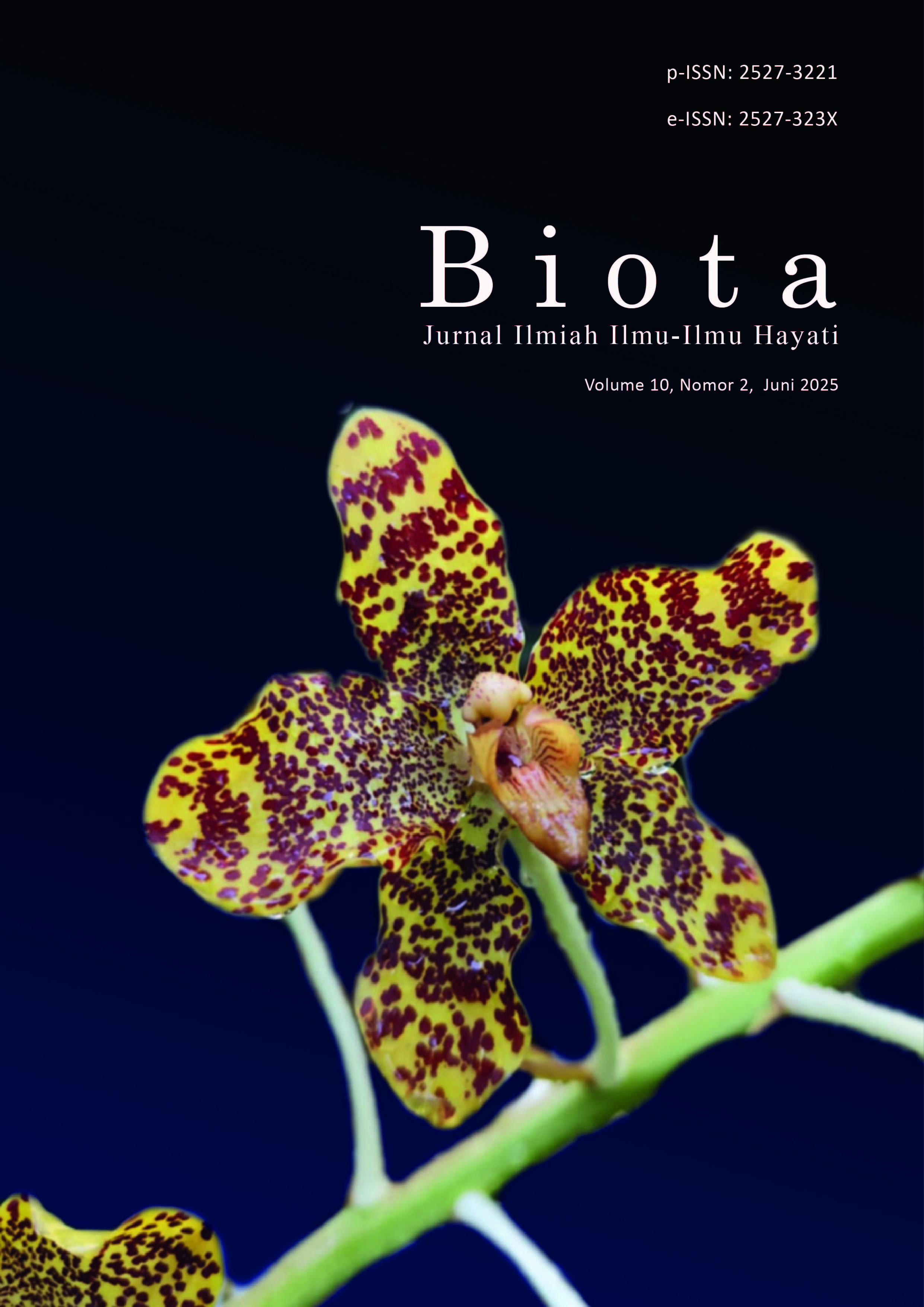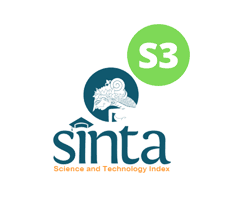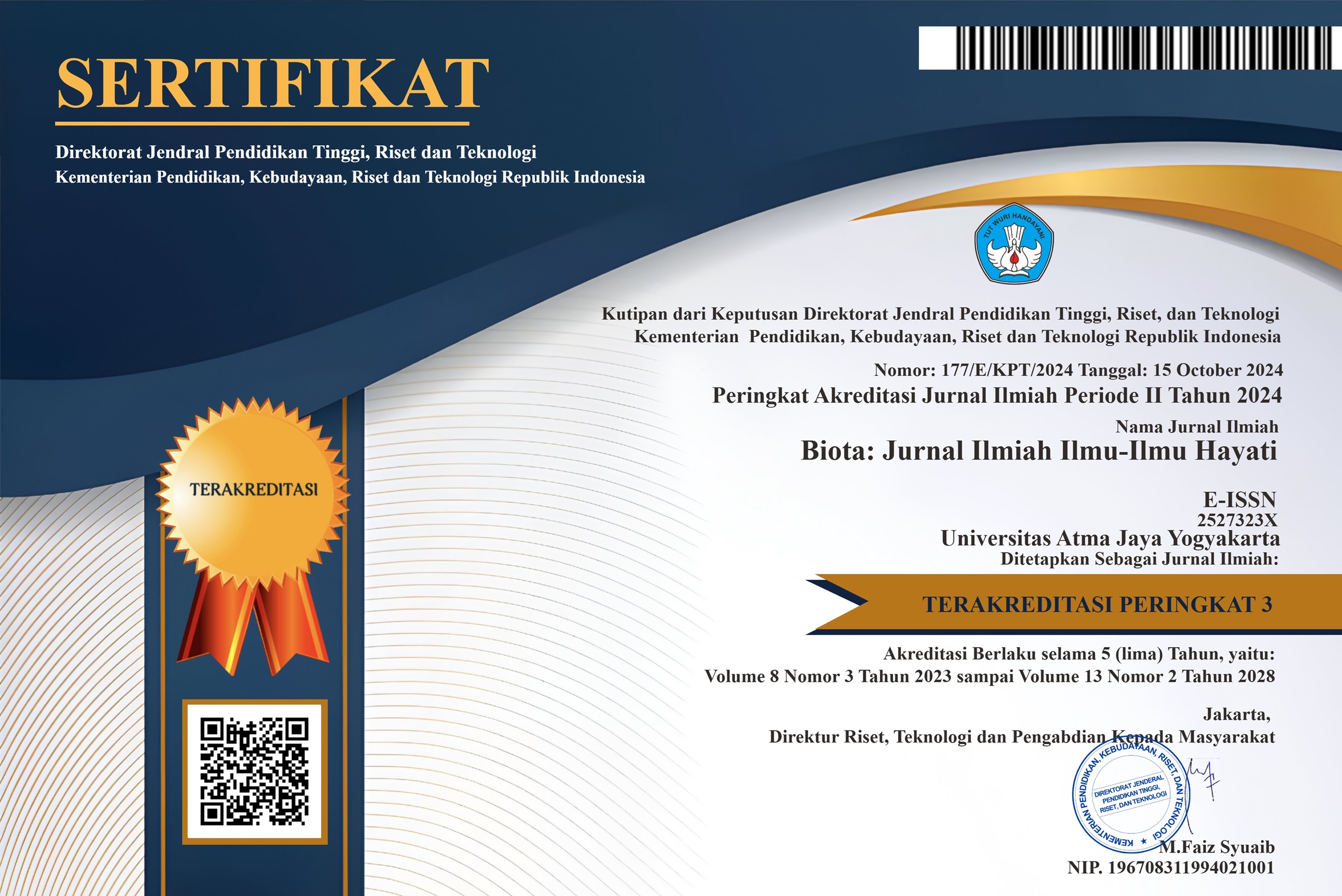Enhancing Red-Chili (Capsicum annuum L.) Growth Using Black Soldier Fly (Hermetia illucens) Probiotics as Carrier
DOI:
https://doi.org/10.24002/biota.v10i2.11214Keywords:
Carrier, growth, Hermetia illucens larvae, probiotics, red chiliAbstract
Red chili (Capsicum annuum L.) is a crucial horticultural commodity in Indonesia, necessitating expansion to meet the growing food demands. The formulation of carriers with probiotics is a promising solution for improving red chili growth. This study examines how the combination of carriers containing bacteria and Trichoderma from the intestines of Hermetia illucens larvae affects the growth of red chili cultivar Lembang-1. The research method used a Randomized Block Design (RBD) with six treatments. The treatment consisted of a group with the addition of a kaolin carrier with bacteria and Trichoderma (BTrK), a talc carrier with bacteria and Trichoderma (BTrT), a zeolite carrier with bacteria and Trichoderma (BTrZ), and a control group without a carrier (KtC), a positive control (K(+)), and a negative control (K(-). The Least Significant Difference (LSD) test showed that the addition of carriers affected increasing plant height and the number of branches compared to the negative control. Specifically, BTrK demonstrated the highest number of leaves and branches. The result concluded that adding carriers with probiotics from the intestine isolate of BSF larvae contributes to the improved growth of red chili. The implementation of carrier addition with probiotics is considered to be a sustainable strategy in agriculture.
References
Agriopoulou, S., Tarapoulouzi, M., Varzakas, T., & Jafari, S. M. (2023). Application of Encapsulation Strategies for Probiotics: From Individual Loading to Co-Encapsulation. Microorganisms 11(12): 2896.
Basheer, J. , Ravi, A. , Mathew, J. , & Edayileveettil Krishnankutty, R. (2019). Assessment of Plant-Probiotic Performance of Novel Endophytic Bacillus sp. in Talc-Based Formulation. Probiotics and Antimicrobial Proteins 11(1): 256–263.
Bhatla, S. C., & Lal, M. A. (2023). Plant Physiology, Development and Metabolism (2nd Edition). Springer: New Delhi
BMKG. (2024). Analisis Hujan. Badan Meteorologi dan Klimatologi, Retrieved Mei 5, 2024, from https://www.bmkg.go.id/iklim/analisis-hujan
Bolan, S., Hou, D., Wang, L., Hale, L., Egamberdieva, D., Tammeorg, P., Li, R., Wang, B., Xu, J., Wang, T., Sun, H., Padhye, L. P., Wang, H., Siddique, K. H. M., Rinklebe, J., Kirkham, M. B., & Bolan, N. (2023). The potential of biochar as a microbial carrier for agricultural and environmental applications. Science of the Total Environment 886: 163968.
Cassel, J. L., Gysi, T., Rother, G. M., Pepper, B. D., Ludwig, R. L. L. L., & Santos, D. B. dos. (2023). In Themes focused on interdisciplinarity and sustainable development worldwide V.1, Benefits of The Application of Silicon in Plants (pp. 864-876). Seven Editora.
Cataldo, E., Salvi, L., Paoli, F., Fucile, M., Masciandaro, G., Manzi, D., & Mattii, G. B. (2021). Application of zeolites in agriculture and other potential uses: A review. Agronomy 11(8): 1547.
Center for Agricultural Data and Information System. (2023). Statistics of food consumption 2023. Secretariat General, Ministry of Agriculture: Jakarta.
Chen, M., Yang, T., Han, J., Zhang, Y., Zhao, L., Zhao, J., & Wu, J. (2023). The Application of Mineral Kaolinite for Environment Decontamination: A Review. Catalysts 13(1): 123.
Comite, E., El-Nakhel, C., Rouphael, Y., Ventorino, V., Pepe, O., Borzacchiello, A., & Woo, S. L. (2021). Bioformulations with Beneficial Microbial Consortia, A Bioactive Compound and Plant Biopolymers Modulate Sweet Basil Productivity, Photosynthetic Activity and Metabolites. Pathogens 10(7): 870.
Dutta, P., Mahanta, M., Singh, S. B., Thakuria, D., Deb, L., Kumari, A., Upamanya, G. K., Boruah, S., Dey, U., Mishra, A. K., Vanlaltani, L., VijayReddy, D., Heisnam, P., & Pandey, A. K. (2023). Molecular interaction between plants and Trichoderma species against soil-borne plant pathogens. Frontiers in Plant Science 14: 1145715.
Harman, G., Khadka, R., Doni, F., & Uphoff, N. (2021). Benefits to Plant Health and Productivity From Enhancing Plant Microbial Symbionts. Frontiers in Plant Science 11: 610065.
Kleruk, Y. A., Beja, H. D., & Wahyuni, Y. (2024). Identifikasi Hama Dan Penyakit Serta Pengendalian Pada Tanaman Cabai (Capsicum Annuum L.) Di Kelompok Tani Sinar Bahagia Desa Nitakloang Kabupaten Sikka Identification Of Pests And Diseases And Their Control In Hili Plants ( Capsicum Annuum L.) At Sinar Bahagia Farmer Group, Nitakloang Village, Sikka Regency. PUCUK: Jurnal Ilmu Tanaman 4(2): 77–84.
Kristi, M., Sanjaya, Y., & Kusnadi, K. (2024). Pengaruh Pemberian Bakteri dan Trichoderma viride dari Isolat Usus Larva Black Soldier Fly (BSF) terhadap Ketahan Penyakit Cabai Keriting (Capsicum annuum). Paspalum: Jurnal Ilmiah Pertanian 12(1): 100–110.
Lob, S., Sa’ad, N. S., Ibrahim, N. F., Soh, N. C., Shah, R. M., & Zaudin, M. S. H. (2023). Enhanced Growth of Chili (Capsicum annuum L.) by Silicon Nutrient Application in Fertigation System. Malaysian Applied Biology 52(2): 13–20.
Mellinia, S. P., Setianto, N. A., Putri, D. D., & Wakhidati, Y. N. (2025). Systematic Literature Review : Faktor-Faktor yang Memengaruhi Produksi Cabai. Jurnal Ekonomi Pertanian Dan Agribisnis (JEPA) 9(2): 621–629.
Minanda, M. A., & Idris, I. (2022). Design and Implementation of Plant Growth Chamber System with Broad Spectrum and High Intensity Lighting: Chili Cultivations Case Study. Proceeding of the 2022 International Symposium on Electronics and Smart Devices (ISESD) (pp. 1–6). Bandung, Indonesia.
Poveda, J., & Eugui, D. (2022). Combined Use Of Trichoderma and Beneficial Bacteria (Mainly Bacillus and Pseudomonas): Development of Microbial Synergistic Bio-Inoculants in Sustainable Agriculture. In Biological Control 176: 105100.
Prisa, D. (2020). Particle Films: Chabazitic Zeolites with Added Microorganisms in The Protection and Growth of Tomato Plants (Lycopersicon esculentum L.). GSC Advanced Research and Reviews 4(2): 1–9.
Raza, T., Abbas, M., Amna, Imran, S., Khan, M. Y., Rebi, A., Rafie-Rad, Z., & Eash, N. S. (2023). Impact of Silicon on Plant Nutrition and Significance of Silicon Mobilizing Bacteria in Agronomic Practices. Silicon 15(9): 3797–3817.
Salim, B., Abd El- Gawad, H., Abou El-Yazied, A., & Hikal, M. (2019). Effect of Calcium and Boron on Growth, Fruit Setting and Yield of Hot Pepper (Capsicum annuum L.). Egyptian Journal of Horticulture, 46(1): 53–62.
Sanjaya, Y., Safrudin, W. H., & Kusnadi, S. (2023). Identification of Microflora from Intestine of Black Soldier Fly Larvae (Hermetia illucens) and its Application for Vegetative Growth of Tomato (Lycopersicum esculentum). Journal of Entomological Research 47(1): 218–222.
Sarmiento-López, L. G., Matos-Alegria, A., Cesario-Solis, M. E., Tapia-Maruri, D., Goodwin, P. H., Quinto, C., Santana, O., & Cardenas, L. (2025). Combination of Nitrogen-Enriched Zeolite and Arbuscular Mycorrhizal Symbiosis to Improve Growth of Maize (Zea mays L.). Agronomy 15(1): 156.
Siregar, R. S., Septyani, I. A. P., Adam, D. H., & Triyanto, Y. (2024). Increasing Red Chili Plants (Capsicum annuum L.) Growth Rate by Administering Photosynthetic Bacteria (PSB) Fertilizer and NPK Fertilizer. Jurnal Agronomi Tanaman Tropika (JUATIKA) 6(2): 538–546.
Sun, Q., Yin, S., He, Y., Cao, Y., & Jiang, C. (2023). Biomaterials and Encapsulation Techniques for Probiotics: Current Status and Future Prospects in Biomedical Applications. Nanomaterials 13(15): 2185
Sutarman, S., & Prahasti, T. (2022). Uji Keragaan Trichoderma Sebagai Pupuk Hayati dalam Meningkatkan Pertumbuhan dan Produksi Tanaman Bawang Merah. Jurnal Agrotek Tropika 10(3): 421.
Wijaya, C. H., Harda, M., & Rana, B. (2020). Diversity and Potency of Capsicum spp. Grown in Indonesia. IntechOpen: London.
Zhineng, Y., Ying, M., Bingjie, T., Rouxian, Z., & Qiang, Z. (2021). Intestinal Microbiota and Functional Characteristics of Black Soldier Fly Larvae (Hermetia illucens). Annals of Microbiology 71(1): 1-9.
Downloads
Published
How to Cite
Issue
Section
License
Copyright (c) 2025 Mulyana Hadid, Yayan Sanjaya, Kusnadi

This work is licensed under a Creative Commons Attribution-NonCommercial 4.0 International License.
Authors who publish with Biota : Jurnal Ilmiah Ilmu-Ilmu Hayati agree to the following terms:
- Authors retain copyright and grant the Biota : Jurnal Ilmiah Ilmu-Ilmu Hayati right of first publication. Licensed under a Creative Commons Attribution-NonCommercial 4.0 International License that allows others to share the work with an acknowledgment of the work's authorship and initial publication in this journal.
- Authors are able to enter into separate, additional contractual arrangements for the non-exclusive distribution of the journal's published version of the work (e.g., post it to an institutional repository or publish it in a book), with an acknowledgment of its initial publication in Biota : Jurnal Ilmiah Ilmu-Ilmu Hayati, and as long as Author is not used for commercial purposes.













